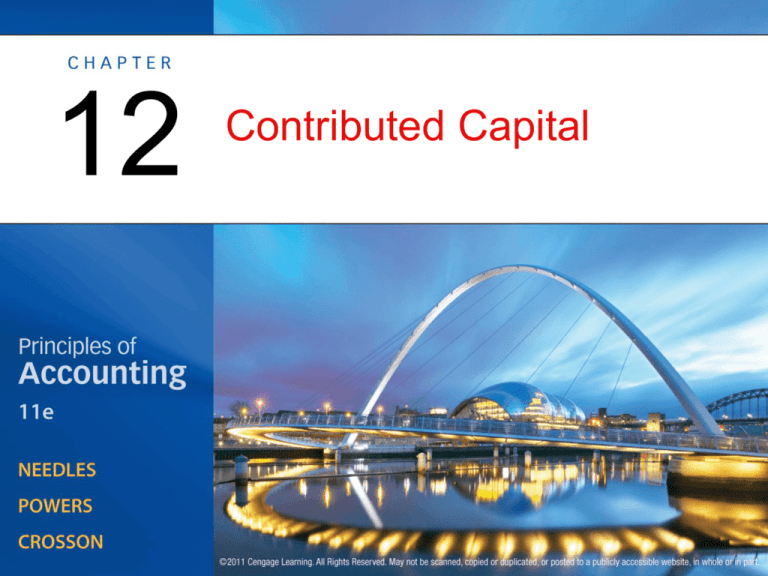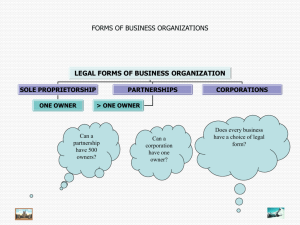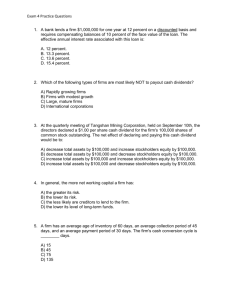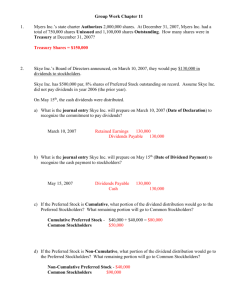
12
Contributed Capital
Management Issues Related to
Contributed Capital
OBJECTIVE 1: Identify and explain the
management issues related to contributed
capital.
Key Ratios
• Dividends yield
• Return on equity
• Price/earnings (P/E) ratio
Figure 1: The Corporate Organization
Figure 2: Dividend Dates
Management Issues Related to
Contributed Capital
• A corporation is a business organization
authorized by the state and considered a
separate legal entity from its owners.
– Articles of incorporation form the company
charter.
– Share of stock is unit of ownership.
– Board of directors decide major business
policies.
Management Issues Related to
Contributed Capital
• A corporation is a business organization
authorized by the state and considered a
separate legal entity from its owners.
(cont.)
– Dividends are distributions of resources to
stockholders.
– Corporate officers are appointed by the board
of directors.
Management Issues Related to
Contributed Capital
• Advantages and disadvantages of corporate
form of business
– Advantages to the corporate form of business.
•
•
•
•
•
•
•
•
Separate legal entity
Limited liability of owners
Ease of capital generation
Ease of transfer of ownership
Lack of mutual agency
Continuous existence
Centralized authority and responsibility
Professional management
Management Issues Related to
Contributed Capital
• Advantages and disadvantages of corporate
form of business(cont.)
– Disadvantages to the corporate form of
business.
•
•
•
•
Government regulation
Double taxation
Limited liability of owners
Separation of ownership and control
Management Issues Related to
Contributed Capital
• Equity Financing
– Par value is an arbitrary amount assigned to
each share of stock; legal capital equals the
number of shares issued times the par value.
– In IPOs, stock is generally issued through an
underwriter.
Management Issues Related to
Contributed Capital
• Equity Financing(cont.)
– Start-up and organization costs consist of all
costs of forming a corporation.
– Start-up and organization costs usually are
expensed when incurred.
Management Issues Related to
Contributed Capital
• Dividend policies
– Stockholders can earn a return on their
investment in one of two ways.
• Through dividends paid by the corporation
• By selling their shares of stock for more than they
paid for them
Management Issues Related to
Contributed Capital
• Dividend policies (cont.)
– The board of directors has sole authority to
declare dividends.
• Dividend policies are usually influenced by top
management.
• Dividends are usually paid when a company has
experienced profitable operations; however, two
other considerations will affect the decision to make
dividend payments.
– The expected volatility of earnings
– The level of cash flows
Management Issues Related to
Contributed Capital
• Dividend policies (cont.)
– The board of directors has sole authority to
declare dividends. (cont.)
• Dividends can be paid quarterly, semiannually,
annually, or as decided by the board of directors.
• A liquidating dividend is the return of contributed
capital to the stockholders and is normally paid
when a company is going out of business or
reducing operations.
Management Issues Related to
Contributed Capital
• Dividend policies (cont.)
– There are three dates associated with a cash
dividend.
• Declaration date
• Record date
• Date of payment
Management Issues Related to
Contributed Capital
• Dividend policies (cont.)
– Stock sold after the date of record is sold exdividend.
Management Issues Related to
Contributed Capital
• Dividend policies (cont.)
– Common ratios
• Dividends yield
• Return on equity
• Price/earnings ratio
Management Issues Related to
Contributed Capital
• The return on equity ratio is the most
important ratio associated with
stockholders’ equity.
– The return on equity ratio is affected by the
following:
• The amount of net income the company earns
• The company’s level of average stockholders’
equity
Management Issues Related to
Contributed Capital
• The return on equity ratio is the most
important ratio associated with
stockholders’ equity. (cont.)
– Stockholders’ equity is affected by
management decisions.
• How much stock a company sells to the public
• How many shares the company buys back on the
open market (reducing the number of shares held by
the public), known as treasury stock
Management Issues Related to
Contributed Capital
• A stock option plan gives corporate
employees the right to purchase stock in a
certain quantity and at a certain price.
– Most plans are intended to compensate
employees (usually management).
– The amount of compensation equals the market
price on the date the option is granted minus
the option price.
©2011 Cengage Learning All Rights Reserved. May not be scanned, copied or duplicate, or posted to a publicly accessible website, in whole or in part.
Components of Stockholders’ Equity
OBJECTIVE 2: Identify the components of
stockholders’ equity.
Exhibit 1: Stockholders’ Equity Section of
a Balance Sheet
Figure 3: Relationship of Authorized Shares to
Unissued, Issued, Outstanding, and Treasury
Shares
Components of Stockholders’ Equity
• Stockholders’ equity is composed of
contributed capital and retained earnings.
• When only one type of stock is issued, it is
called common stock.
• The second kind of stock a company can
issue is preferred stock.
Components of Stockholders’ Equity
• Authorized shares are the maximum
number of shares the corporation is allowed
to issue according to its state charter.
• Issued shares represent the number of
shares sold or otherwise transferred to
stockholders.
• Outstanding shares are shares that have
been issued and are still held by
stockholders.
©2011 Cengage Learning All Rights Reserved. May not be scanned, copied or duplicate, or posted to a publicly accessible website, in whole or in part.
Preferred Stock
OBJECTIVE 3: Identify the characteristics of
preferred stock.
Preferred Stock
• Holders of preferred stock are given
preference over common shareholders
when dividends (and liquidating dividends)
are declared; that is, the holders of
preferred shares must receive a certain
amount of dividends before the holders of
common shares can receive dividends.
– This dividend is a specific dollar amount or
percentage of par value.
Preferred Stock
• Holders of preferred stock... (cont.)
– Preferred stockholders receive their dividends
before common stockholders receive anything.
– Once preferred stockholders have received the
annual dividends to which they are entitled,
however, common stockholders generally
receive the remainder.
Preferred Stock
• Dividends in arrears are unpaid “back
dividends” on cumulative preferred stock.
• When a dividend is declared by the board
of directors, Cash Dividends Declared is
debited and Cash Dividends Payable is
credited.
Preferred Stock
• Convertible preferred stock can be
exchanged for common stock at a
predetermined ratio.
• Callable preferred stock can be redeemed
or retired at the option of the issuing
corporation.
©2011 Cengage Learning All Rights Reserved. May not be scanned, copied or duplicate, or posted to a publicly accessible website, in whole or in part.
Issuance of Common Stock
OBJECTIVE 4: Account for the issuance of
stock for cash and other assets.
Issuance of Common Stock
• Common and preferred stock may or may
not have a par value.
– Par value is the legal value established for a
share of stock.
Issuance of Common Stock
• No-par stock may be issued with or without
a stated value.
– The total stated value is recorded in the Capital
Stock account. Any amount received in excess
of the stated value is recorded as Additional
Paid-in Capital.
– If no stated value is set, however, the entire
amount received constitutes legal capital and is
credited to Capital Stock.
Issuance of Common Stock
Issuance of Common Stock
• When stock is issued in exchange for assets
or for services rendered, the stock should
be recorded at the fair market value of the
assets or services, unless the fair market
value of the stock is more easily
determined.
©2011 Cengage Learning All Rights Reserved. May not be scanned, copied or duplicate, or posted to a publicly accessible website, in whole or in part.
Accounting for Treasury Stock
OBJECTIVE 5: Account for treasury stock.
Accounting for Treasury Stock
• Treasury stock is issued stock that the
issuing corporation has reacquired for any
of the following reasons:
– To use for stock option plans
– To maintain a favorable market for the
company’s stock
– To increase earnings per share
Accounting for Treasury Stock
• Treasury stock is issued stock that the
issuing corporation has reacquired for any
of the following reasons: (cont.)
– To use to purchase other companies
– To prevent a hostile takeover of the company
Accounting for Treasury Stock
• Treasury stock is the last item (a deduction)
in the stockholders’ equity section of the
balance sheet.
– Treasury stock appears on the balance sheet as
the last item in the stockholders’ equity section,
as a deduction.
Accounting for Treasury Stock
• Treasury stock is the last item (a deduction)
in the stockholders’ equity section of the
balance sheet. (cont.)
– Reissuance of treasury stock (at cost, above
cost, and below cost).
• When cash received from reissuance exceeds the
cost, the difference is credited to Paid-in Capital,
Treasury Stock.
• When cash received from reissuance is less than the
cost, Paid-in Capital, Treasury Stock (and Retained
Earnings, if needed) is debited for the difference.
• In no instance should a gain or loss account be
established.
Accounting for Treasury Stock
• Treasury stock is the last item (a deduction)
in the stockholders’ equity section of the
balance sheet. (cont.)
– Gains and losses are not recognized on treasury
stock transactions.
Accounting for Treasury Stock
• When stock is retired, all the contributed
capital associated with it must be removed
from the accounts.
– When less was paid on reacquisition than was
contributed originally, the difference is credited
to Paid-in Capital, Retirement of Stock.
– When more is paid, the difference is debited to
Retained Earnings.
Accounting for Treasury Stock
©2011 Cengage Learning All Rights Reserved. May not be scanned, copied or duplicate, or posted to a publicly accessible website, in whole or in part.








